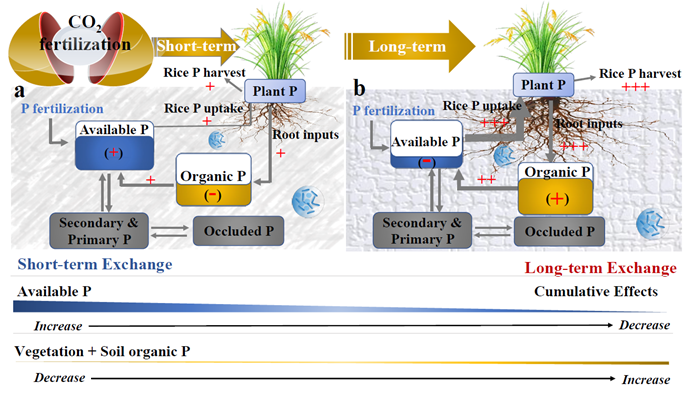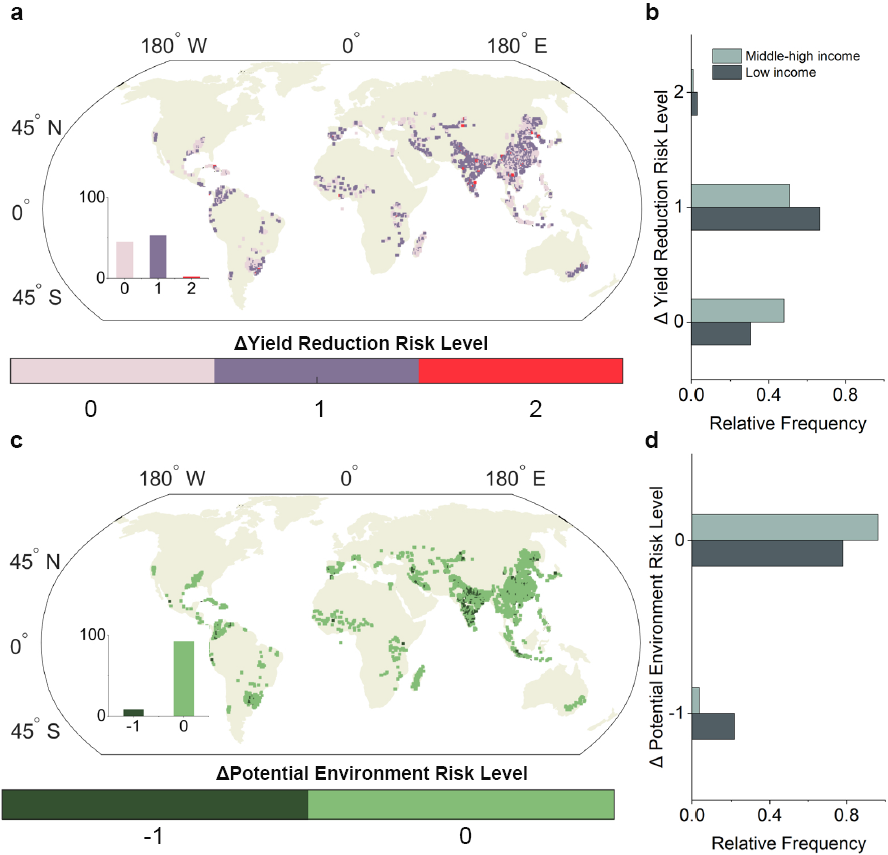
This hope, however, is conditioned upon some factors, including sufficient nutrients supplies to support crops. Such as phosphorus (P), which is one of the must-have nutrients.
Dr. WANG Yu and Prof. ZHU Chunwu from Institute of Soil Science of the Chinese Academy of Sciences based on two unique long-term (15 and 9 years) rice FACE experiments, found however, elevated CO2 (eCO2) decreased soil available P by more than 20%. FACE stands for the Free Air CO2 Enrichment, the primary technology scientists used to elevate the concentration of atmospheric CO2 and examine the responses of biosphere. It is not cheap, and it is not easy to maintain, making decade-long FACE experiments rare and precious worldwide.
The study was published in Nature Geoscience on Jan.19. It was the first decade-long study on phosphorus in rice paddy fields under elevated CO2. Through systematic examination of possible processes and multiple soil, plant, microbial, and geochemical indicators, the cumulative and progressive lock-up of P in plant-unavailable organic forms as soil organic P or removal through harvest was regarded as the major mechanism that shifted P availability through time, despite the acceleration of biological, biochemical and chemical transfers of P into available forms under eCO2.

Fig1 Conceptual model illustrating the effects of eCO2 on soil P pools in paddy soils in short-term (a) and long-term (b)
Could we compensate for CO2-induced phosphorus reductions and remove the constraints on the CO2 fertilization effect, at least for the nutrient-related issues, simply by adding fertilizers? Every coin has two sides. Historical excessive P fertilization to maximize crop production has led to the accumulation of soil P in some regions, such as Europe, North America, and southeastern Asia. Accumulated soil P is easy to loss to water bodies through surface and subsurface runoff, leaching and erosion, can result in eutrophication.
In addition, not every place could get fertilizer P resources as they want. Chemical P fertilizer is produced from rock phosphate, which is an unrenewable and unevenly distributed resources. Morocco and Western Sahara have around 70% of the world's total phosphate reserves and many countries rely on imports for their P fertilizers. In regions without increased P fertilizers supply, or with highly weathered soils that strongly bind the added P fertilizer, prolonged P deficit could limit yields, which may be exacerbated under future continuously increasing levels of atmospheric CO2 and global changes. This is not the first time we are nervous of P shortage. During the 2007-2008 global food crisis, phosphate rock and fertilizer demand increased by 400% within a 14-month period, and we still remember the strong socioeconomic instability associated with phosphorus.
This study is possible only through the world unique long-term experiments, not only reconcile the dispute on multiple speculations on plausible P availability trajectories, but also emphasize the urgency in establishing sound P management planning and strategies factoring in future global changes. It projected a larger risk of rice yield reduction especially in low-income countries under future eCO2 without compensatory additional P fertilizer inputs, a situation that place poor countries under more adverse conditions and further widen the economic inequality due to CO2 emissions and the impacts on geochemical processes.

| Fig2Changes in rice yield reduction and potential P pollution risks due to eCO2 |
This research is a multiple country collaborative work. The authors come from Institute of Soil Science (Chinese Academy of Sciences), CSIRO Oceans and Atmosphere, Nanjing University, Institute of Urban Environment (Chinese Academy of Sciences), University of Alberta, Cornell University, Université Paris-Saclay, CSIC (Global Ecology Unit CREAF-CSIC-UAB), CREAF (Cerdanyola del Vallès), Adaptive Cropping Systems Laboratory (U. S. Department of Agriculture, Agricultural Research Service), Swift Current Research and Development Centre (Agriculture and Agri-Food Canada), North Carolina State University, Nanjing Institute of Environmental Sciences (Ministry of Ecology and Environment), and Auburn University.
Attachment Download: